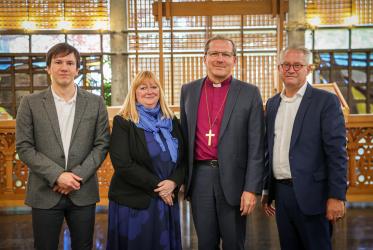Orthodox Church of Finland
(Suomen ortodoksinen kirkko)
Orthodox Christianity was brought to eastern Finland by merchants and missionary monks around a thousand years ago. The first recognized institution was Valamo Monastery on Lake Ladoga, founded by the Byzantian monk Sergius and his Karelian disciple Herman in the 12th century. Orthodox parish life in Finland was already vibrant in medieval times. The Orthodox parishes formed a separate diocese in the Russian Church from 1893. When Finland gained independence in 1917, the Orthodox population still lived mainly in the Province of Karelia, although there were a few parishes in towns in western and southern Finland. In the new republic of Finland the position and the rights of the Orthodox Church were defined and settled by a government edict in 1918. The Orthodox Church received the same status as the predominant Lutheran Church of Finland, and it thus constitutes the second national church of the country. In 1923 the Finnish Orthodox Church had its canonical status clarified and became an autonomous church within the Ecumenical Patriarchate of Constantinople. The church enjoys a high degree of independence. The bishops are elected by the general assembly, which includes bishops and representatives of clergy and laity. Only the election of a new archbishop has to be confirmed by Constantinople.
The second world war had drastic effects. Of the Orthodox who lived in the eastern part of the country, which was then occupied by the Soviet Union, 75 percent had to move to other parts of Finland. The church lost most of its property, including the historical sites of its four monasteries. Fortunately the national government granted special financial support to construct more than 50 church buildings and vicarages all over the country.
Everyday Finnish and a modern translation of the Bible are used in liturgical life. Many books for liturgical use and devotional needs are printed. The translation of liturgical texts and adaptation of Byzantine and Russian melodies into Finnish continues. In the field of religious art the church makes an important contribution to the national religious culture. Icon painting has developed a particular Finnish style. There are several hundred active icon painters in the country, many of them Lutheran. Theological studies and research are mainly done at the Orthodox department of the University of Joensuu, where Orthodox pastors, teachers and cantors are trained. Students take a five-year MA degree in theology before priesthood. Students live in a boarding house (seminary), where they participate in regular worship and receive pastoral counselling during their studies.
The Monastery of New Valamo has developed into a national centre for pilgrimage. There are now 12 monks and novices. Its spiritual and cultural mission and witness are supported by the lay academy, icon renovation centre, library and conference facilities. There is also Lintula Convent with 15 nuns nearby. The church supports the Patriarchate of Alexandria in Orthodox missionary activities in Kenya and Uganda. In this connection a number of schools and nurseries have been established.
Orthodoxy is a popular part of the national culture today. Its visibility and influence largely exceed its size. Many converts to Orthodoxy and immigrants today bring new blood and energy, which is being utilized by the church in an open and creative way in a country which also provides a unique model through its ecumenical openness and mutual trust between the two national churches. The Finnish Orthodox Church participates in both pan-Orthodox and ecumenical meetings in a committed way. This includes various bilateral international dialogues. The church hosted the International Catholic-Orthodox Dialogue at New Valamo in 1988 and the Anglican-Orthodox International Commission in 1989. Orthodox youth take a very active role in international Orthodox youth work.
More on the Orthodox Church of Finland:
New Valamo, a living monastic tradition in Finland
A multimedia portrait of the Finnish monastery of the Transfiguration of Christ, including a 'Blessing of Waters' ceremony on the feast of Epiphany, can be viewed on the 'Keeping the Faith' website.




